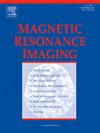胎儿生长受限对局部脑容量发育和神经发育结局的影响:基于全自动分割方法的磁共振成像证据
IF 2
4区 医学
Q2 RADIOLOGY, NUCLEAR MEDICINE & MEDICAL IMAGING
引用次数: 0
摘要
目的探讨胎儿生长受限(FGR)对脑容量发育的影响,寻找预测神经发育不良的影像学指标。方法收集27 ~ 38周超声诊断的FGR胎儿及匹配的正常胎儿的MRI图像。对各向同性高分辨率图像进行重建和处理,提取出17个脑区。随后,计算各脑区体积及其与总脑体积的比值。采用logistic回归分析确定影响神经发育结局的独立危险因素。结果本研究纳入51例FGR胎儿和78例健康对照。两组间扣带回、脑干、胼胝体、基底节区、岛叶、额叶、颞叶、顶叶和脑脊液占总脑容量的比例差异有统计学意义(P<0.05)。预后组28例胎儿神经发育良好,15例胎儿神经发育不良。脑干比例被确定为神经发育不良结局的独立预测因子(OR: 2.069;95% CI: 1.061至4.035)。结论FGR胎儿脑发育不受限制。此外,脑干与总脑容量的比例可能与神经发育不良有关。本文章由计算机程序翻译,如有差异,请以英文原文为准。
Effect of fetal growth restriction on the development of regional brain volume and neurodevelopmental outcomes: Evidence from magnetic resonance imaging based on a fully automated segmentation method
Purpose
To investigate the impact of fetal growth restriction (FGR) on brain volume development and to identify imaging indicators predictive of poor neurodevelopmental outcomes.
Methods
The MRI images of fetuses with FGR diagnosed by ultrasound at 27–38 weeks and matched normal fetuses were collected. The isotropic high-resolution images were reconstructed and processed to extract 17 brain regions. Subsequently, volume and the ratio to total brain volume of each brain region was calculated. Using logistic regression analysis to identify the independent risk factors of the neurodevelopmental outcomes.
Results
The study included 51 FGR fetuses and 78 healthy controls (HCs). Significant differences were discovered in the cingulate gyrus, brainstem, corpus callosum, basal ganglia, insula, frontal lobe, temporal lobe, parietal lobe and cerebrospinal fluid of their ratio to the total brain volume between the two groups (P<0.05). The prognostic group consisted of 28 fetuses with good fetal neurodevelopment and 15 fetuses with poor neurodevelopment. The ratio of brainstem was identified as independent predictors for poor neurodevelopmental outcome (OR: 2.069; 95 % CI: 1.061 to 4.035).
Conclusion
Brain development was not uniformly restricted in FGR fetuses. Additionally, the ratio of brainstem to total brain volume may be associated with poor neurodevelopment.
求助全文
通过发布文献求助,成功后即可免费获取论文全文。
去求助
来源期刊

Magnetic resonance imaging
医学-核医学
CiteScore
4.70
自引率
4.00%
发文量
194
审稿时长
83 days
期刊介绍:
Magnetic Resonance Imaging (MRI) is the first international multidisciplinary journal encompassing physical, life, and clinical science investigations as they relate to the development and use of magnetic resonance imaging. MRI is dedicated to both basic research, technological innovation and applications, providing a single forum for communication among radiologists, physicists, chemists, biochemists, biologists, engineers, internists, pathologists, physiologists, computer scientists, and mathematicians.
 求助内容:
求助内容: 应助结果提醒方式:
应助结果提醒方式:


